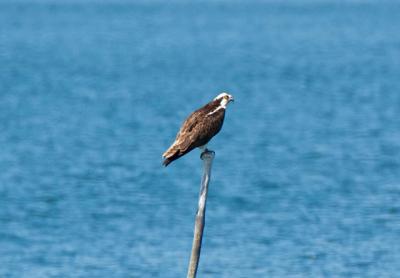Nature Notes: So Long, Summer

The autumnal equinox has come and gone, just like that! Prepare for early evenings and late mornings. The birds were hip to equinoxes before the modern humans. Their intellects don’t obfuscate their primary objective. They are already on their way south. The winter birds — white-throated sparrows, juncos, and the like — may be here in a few days. I have yet to see one. Some flocks of Canada geese from the north have already left us, and the sea ducks, loons, and grebes have yet to show up. At least they haven’t yet come to my neighborhood at the edge of Noyac Bay.
We still see an osprey or two flying around. All of the young have fledged, and a few made practice nests, it seems, on utility poles before leaving. The cormorants at the end of the fish trap on Long Beach are still hanging out. They don’t seem to be feeding, but maybe there are so many fish in the water that they finish feeding early, then perch and socialize for the rest of the day while digesting their fill.
By all reports there have been a lot of fish in the bays this year. As in the last couple of years, bunkers are especially prevalent. So far, no big fish kills have taken place as they have in Long Island bays during the last several years. Cross your fingers. Terry Sullivan has been checking out the local waters several days a week as he does every year, year round.
For the past three weeks he has been watching a mass of menhaden, also peanut bunkers, in Otter Pond in Sag Harbor. If you drive by, you are liable to spot two great egrets and a great blue heron standing straight up on the northern shore within inches of one another. And there is usually a cormorant or two. If you stop and look closely, you may witness what Terry has been observing these days: killer mallards.
Who would imagine that the mostly herbivorous mallards would stoop to eating baby menhaden? But that seems to be the case in Otter Pond. Yes, there are sea ducks, scoters, eiders and the like, and loons, that regularly feed on small fish when available, but mallards? It just goes to show that in nature very little goes to waste. It’s not the birds and other vertebrates that are causing the Pacific Ocean’s “plastic gyre” that is said to be as big as the State of Texas.
Fortunately, the bunkers swarming in Otter Pond have yet to draw down the oxygen to dangerous levels.
This is also the season when the salamanders, toads, frogs, and other hibernating amphibians begin to hole up. The arboreal spring peepers that have been with us helping to keep the mosquito population in check since April will also be hibernating shortly. If you go into the wild areas with ponds that they frequent, you will often hear them uttering weak peeps. I wonder if they are signaling that it’s time to go under so that the other lollygagging peepers will take notice.
Those beautiful wood warblers that sparkle when they arrive in May from the South, have dropped their brightly colored feathers for duller ones. The males no longer have to impress the females and come to look more like them in the nonbreeding season. The only singing bird that I occasionally hear in my environs these days is the Carolina wren. For some unknown reason, the males of this species will from time to time utter their repetitious phrases even in the dead of winter.
Whether it is a fluke or attributable to global warming, this was the most difficult summer heat and humidity-wise that I have experienced in my 82 years. I am actually happy to see it go, and look forward to the blooming of the fall asters and goldenrods, the gaily colored leaves still clinging to the hardwood trees before they fall to the ground, and the flight of the monarchs as they flutter south.
Watch out for chiggers and ticks and drive carefully. The squirrels and chipmunks are busy crossing streets looking for acorns to stock their winter larders.
Larry Penny can be reached via email at [email protected].
